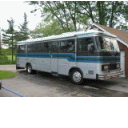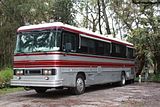Page 1 2
Go to...  | Start A New Topic  | Search  | Notify  | Tools  | Reply To This Topic  |  |
 8/10 8/10 |
So now I'm on the fence as to whether or not the braided fill-line is safe or should be replaced with something ridged(???) The braided line has to be a standard on the Barth Regencies with 40 gallon tanks mounted amidship, up-between the frame rails, with a filler port in a small compartment on the port side. Curious how many other Regency Owners have this configuration? The couplings ARE NOT a "screw-in" type ...they are a crimp-on style of coupling that were installed on a new, 5-foot chunk of hose, by a company who has been in the vehicle conversion, propane business for over 30 years, so I doubt these guys would have steered-me-wrong. Any other thoughts on the safety of this set-up which was presumably, originally installed by BARTH? I have the same type of hose for aproximately 2-feet near the generator. ~Mac~ 1990 31 Foot Regency Spartan Chassis Cummins 6CTA8.3 Alison MT643, 4-speed 8905-0123-31RDS-A2 | |||
|
| First Month Member |
Well, these are just thoughts, since I haven't read the DOT or RVIA regs in a very long time, and am not a propane professional. We had DOT regs at work for our propane powered equipment, but I am far far away right now.
The propane hose used by my hose man is rated at up to 350 psi working and bursts at 1750 psi. Most relief valves let go at a little under or a little over 300 psi. If the fill valve is on the tank, it will close at the end of filling, and there should be no pressure in the fill hose. Even if the fill valve lets pressure in to the fill hose, the pressure in the hose will be below its rated capacity and the limit of the tank relief valve (which is below the hose rated pressure, and way below the burst pressure).
Don't know the numbers, but the pump is there to speed transfer. The high pressure in the truck hose is just for speed, and the pressure in the tank never gets above the relief valve setting, or you would hear it let go. The coldness of the fill connection is also evidence of the pressure reduction. So, pending confirmation from the RVIA, I wave my wand of design flaw absolution over the Barth factory who installed the fill hose set up.
The relief valve on the tank and the regulator in the line should protect the appliances. If the relief valve is working, the pressure in the tank will never be over ~300 psi, and the appliances will never see over 11" H2O.
Never hurts to be extra safe. My own bugbear is the filling guy who does not close the spit valve completely. Early on in RVing, I found myself out in the bushes with no propane on account of a slowly seeping spit valve. I would recommend everyone buy a hand held propane detector. Or brush soapy water over every hose and connection often. By the time a leak is visible or discovered, a lot of propane could have leaked out with a lot of danger exposure. . 84 30T PeeThirty-Something, 502 powered | |||
|
 |
Since it has stopped raining I went out and checked. The filler line and the take off for a bbq grill are both flex lines from the filler door to the tank. Everything else is iron. The flex lines have a silver tag attached with, QUOTE: ... "UL CODE: MODEL A6 FLEXIBLE HOSE CONNECTOR FOR LP GAS ... MODEL 604H 350 MAX WK PRESS." We have a mid entry coach and the filler is on the STARBOARD SIDE right next to the entry door. Also there is no connection to the generator because it is a an Onan diesel genny! It is the OEM setup I'm sure. Don
1990 Regency 34' Cummins 6CTA 8.3 240hp Spartan Chassis, 4 speed Allison MT643 | |||
|
 8/10 8/10 |
I concur that this is probably an OEM practice and since it is only a fill line, then it seems that this is a safe configuration. That's a tough 5-feet of hose with the ends crimped-on. As other's have mentioned, due to the sudden frequency of failures and the similiar age of most of these coaches, everyone should do an inspection of this line [and other flex-lines on the coach] and consider replacing-it just to be on the safe-side... I think I'll preventively replace the one at my generator this coming season. ~Mac~ 1990 31 Foot Regency Spartan Chassis Cummins 6CTA8.3 Alison MT643, 4-speed 8905-0123-31RDS-A2 | |||
|
| First Month Member |
My Barth has a flex line connecting the tank to the coach. A while back, I replaced it just to be safe, but made the new one longer. This allows me to connect the coach to our portable 5 gallon tank if we run out while parked in the sticks and don't feel like picking up and driving the rig to town. Sort of a poor man's Extend-A-Stay. . 84 30T PeeThirty-Something, 502 powered | |||
|
"5+ Years of Active Membership" 9/11 9/11 |
I had to replace my fill line just before the Hillsboro River State Park GTG. When I pulled my old one off it was just over 9 feet long. The service guy I went to cut a new line put on new crimp fittings. It was the same problem that Mac had. All owners with old Barths should check and replace those LP flex fill lines or other LP flex lines. Jim 1985 Barth Regency | |||
|
| Powered by Social Strata | Page 1 2 |
| Please Wait. Your request is being processed... |
|
This website is dedicated to the Barth Custom Coach, their owners and those who admire this American made, quality crafted, motor coach.
We are committed to the history, preservation and restoration of the Barth Custom Coach.
We are committed to the history, preservation and restoration of the Barth Custom Coach.

